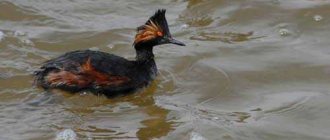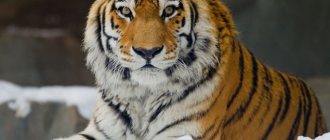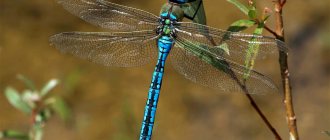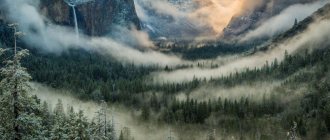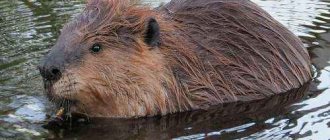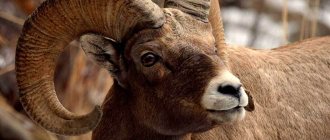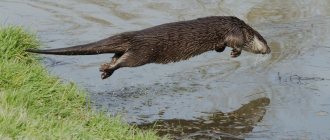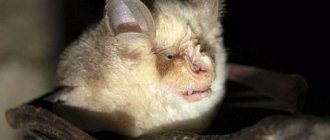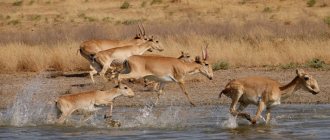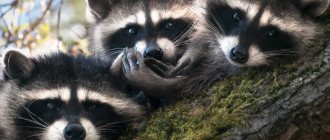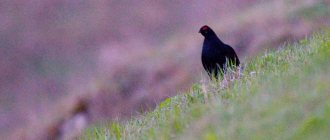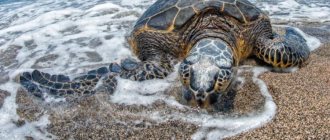In the Krasnodar Territory, wild animals live in forests, meadows, highlands with steep peaks, lakes and rivers. In Kuban, the climate is mild and temperate all year round, winters are short and not frosty, and in summer it is cool in the mountains and near the water.
The steppe lowlands are inhabited by burrowing rodents that are invisible to humans. For agriculture, proximity to gophers, mice, jerboas, moles and hamsters is fraught with loss of part of the harvest. Humans are helped by ferrets, foxes and weasels - steppe predators and owls, kites, harrier - birds of prey that catch rodent pests at night.
Birds nest near fields and in cities, where they feed on plant seeds and leftover human food.
Caucasian forest cat
A small representative of felines living in mountainous areas among deciduous trees. Outwardly, it can be confused with an ordinary cat, because the weight of an adult individual barely exceeds 7 kg. The animal is predominantly nocturnal. Despite its small size, the forest cat is still a predator and feeds on squirrels, partridges, rodents, ducks and other small animals. Often attacks young artiodactyls. Most often, the forest cat can be found in forests near the rivers: Kuma, Kuban, Terek. The number of Caucasian cats is between 2-3 thousand individuals.
Central Asian leopard
The largest representative of the cat family in the Krasnodar region. Its golden-hued coat cannot be confused with other cats in the region. The weight of an adult male reaches 70 kg, and the total length is at least 127 cm, including the tail. The predator feeds on artiodactyls and is an endangered animal. The Central Asian leopard chooses forests and meadows for its habitat, and often settles near cliffs and rocks.
Caucasian lynx
A graceful animal from the cat family. It is small in size - up to 50 cm in height and up to 115 cm in length. It easily climbs trees while hunting and often makes its home there. The Caucasian lynx has brownish-red fur and bright spots. Its tail is short, and its ears have tufts of hairs (tassels), like other subspecies.
There are no more than 45 individuals left in the Krasnodar Territory, 16 of which are listed in the Sochi National Park. Lynxes prefer to live in narrow places, so hollows, crevices between tree roots, and small caves are often chosen for dens. During one pregnancy, the female bears a maximum of 2 kittens. They are trying to increase the number of Caucasian lynx using artificial methods, and scientists are succeeding in this.
ANIMAL WORLD OF THE KRASNODAR REGION project on the surrounding world (senior group) on the topic
Slide 1
LIVING WORLD ECOLOGICAL PROJECT OF THE KRASNODAR REGION senior group teacher Cherepanova Yu.M.
Slide 2
RELEVANCE OF THE PROJECT Ecology is a science that teaches us to take care of the environment, the Earth. This world is colorful and bright. The Earth is our Green Home. Seas and rivers, forests and mountains, villages and cities... There is so much in this wonderful house! And together with us, plants and mushrooms, insects and fish, birds and animals live in it. "Do no harm!" - one of the commandments of human communication with nature. Raising young preschoolers in the spirit of environmental conservation is one of the aspects of environmental education in kindergarten. Love, understanding and care are what nature expects from every person. It is advisable to begin to cultivate these feelings in early childhood, which is why today environmental education in preschool educational institutions is given great attention.
Slide 3
To form children’s understanding of the fauna of the Krasnodar region and their habitats. Develop cognitive interest, the ability to use previously acquired knowledge in work, the ability to reason, analyze, and correctly express one’s thoughts. To cultivate a love of nature and a culture of behavior in recreational areas close to nature. OBJECTIVE OF THE PROJECT
Slide 4
Project passport TYPE OF PROJECT: group, creative TYPE OF PROJECT: information-practice-oriented PROJECT PARTICIPANTS: teachers, children of the senior group, parents IMPLEMENTATION DATE: December-February 2016-2017 academic year
Slide 5
STAGES OF PROJECT IMPLEMENTATION PREPARATORY STAGE selection of advisory material for teachers and parents; drawing up a project passport; selection of fiction; production of didactic games; selection of gaming and didactic material; design of information and educational material for parents
Slide 6
MAIN STAGE – PRACTICAL FORMS OF WORK *reading fiction “Bathing Bear Cubs”, “The Fox and the Mouse” - V.V. Bianchi “Wolf” - E.I. Charushin “My Motherland”, “Golden Meadow” - M.M. Prishvin “Who Lives in the Sea” - S.V. Sakharnov “First Hunt” - V.V. Bianki “Meeting of Winter” - I.S. Nikitin “All Year Round” - S.Ya. Marshak “Where the Fish Sleeps” - I.P. Tokmakov “Forest Pictures” - I.S. Sokolov-Mikitov
Slide 7
GAME ACTIVITIES didactic games * “What kind of animal”, “Where does it live” Purpose: to strengthen children’s ability to recognize and correctly name animals and their habitat. * “Who is he?”, “What does he eat?” Goal: to teach to distinguish animals by external signs and what they eat. * “Once upon a time in the forest..” Goal: to consolidate the ability to come up with short stories with the proposed animal characters. * “Whose mother”, “Whose baby” Goal: to consolidate the ability of children to correctly name animals and their babies * “Find the differences”, “How are they alike” Goal: to consolidate the ability to name the differences and similar qualities of animals.
Slide 8
cognitive activity Game situations, conversations: “Animals of our region” * badger, * wild boar * jungle cat * lynx * mink * otter * bear * spotted deer * squirrel Purpose: to give initial ideas about animals, teach to distinguish by external signs, correctly name cubs , develop the ability to establish simple connections between the inhabitants of the forest, and arouse interest in their lives.
Slide 9
Game situations, conversations “Birds of our region” Waterfowl *geese *ducks *swans Inhabitants of forests and fields *lancer *grouse *lark *thrush *bittern *crane *partridge Purpose: to introduce children to the features of bird life, to show the relationship of birds with their habitat , teach to analyze and establish cause-and-effect relationships.
Slide 10
ARTISTIC AND PRODUCTIVE ACTIVITY Game situations *MOLDING “Animals”, “Birds” Purpose: to teach to convey the characteristic features of the appearance of animals and birds, sculpt in a constructive way from 4-5 parts *DRAWING “Mouse and Sparrow”, “Who, who lives in a mitten » Goal: to teach how to create plots based on literary works. “Like pink apples on bullfinch branches..” Goal: to develop the ability to create a simple composition, to convey the features of the appearance of birds. APPLICATION “The gray bunny became white” Purpose: transformation of the expressive image of the bunny: it was gray and became white - gluing a gray silhouette and painting with white gouache. Drawing animals and birds on the snow and sand with sticks. The goal is to teach how to convey characteristic features.
Slide 11
FINAL STAGE Expected results Develop interest in the fauna of the Krasnodar region Strengthen ideas about the needs of animals and birds for their growth and development Develop feelings of empathy for all living things, the ability to draw basic conclusions. Educating parents, providing them with the necessary information on emerging issues Creating a model of the forest and its inhabitants
Slide 12
The fauna of Kuban is rich - bear and bison, deer and elk. If I had to walk in the forest, I would see the tracks of a boar. (K. Oboishchikov)
Slide 13
CONTENTS Nature of the native land. Fauna: a) animals, b) birds
Slide 14
The landscapes of the Black Sea region are extremely diverse - from subtropics to snowy peaks. The human imagination is amazed by mud volcanoes and wild gorges, bizarre rocks and glaciers, waterfalls, caves, rare plants and animals.
Slide 15
Just one hundred to two hundred years ago, on the territory of the Black Sea coast there were many wild animals, among which were species found only here. Such animals include, for example, the Western Caucasian tur (Severtsov's tur), Promethean mouse, Caucasian snowcock (mountain turkey), Caucasian black grouse, Caucasian viper (Koznakov's snake) and others. This is explained by the fact that in the distant past the Caucasus existed for a long time as an island surrounded by the sea.
Slide 16
New inhabitants also appeared in the Caucasus. The Altai squirrel and raccoon dog were released into the forests of the Northwestern Caucasus, and later the North American raccoon, muskrat, and nutria, which were not here before. Already in the 80s, sika deer, European fallow deer, stone partridge and gray partridge were brought to the region.
Slide 17
Later, sika deer, European fallow deer, stone partridge and gray partridge were brought to the region.
Slide 18
When vacationing on the coast, a person spends his time at sea more often and therefore sees dolphins and seagulls much more often than forest animals and birds. However, once you move a few kilometers into the mountains, an encounter with the inhabitants of the subtropical forest becomes inevitable.
Slide 19
The “master of the forest” is the Caucasian bear. In terms of height and strength, it is inferior to the brown bear of central Russia. He walks around his possessions slowly and confidently. In summer it can be seen in forest clearings and meadows. In autumn, when chestnuts, wild pears, and beech nuts ripen, the clubfoot feeds on them. Due to the abundance of plant food, the Caucasian bear almost never resorts to hunting large mammals. An encounter with a Caucasian bear is not dangerous for humans. The clubfoot is very cowardly, and it is easy to turn him into a stampede with an unexpected cry, whistle, or shot.
Slide 20
Wild pigs are also widespread in the forest zone. Unlike domestic ones, they are shorter in body length, but taller on the legs. Their body is covered with thick dark brown bristles. Already at the first glance, they are struck by their exorbitantly large, but narrow and long head and disproportionately narrow body. Males are armed with long and dagger-sharp fangs. Wild pigs usually go out to feed at night. They feed on various fruits, acorns, nuts, and chestnuts. The main habitat is coniferous and beech thickets.
Slide 21
One of the representatives of predators is the wild cat. It is larger and stronger than a domestic cat. The coat color is dark. Its favorite habitat is dense deciduous forests, lowlands, river valleys, rock crevices, caves, hollows and holes. The main food is small rodents. The fur of wild cats is particularly durable. CAUCASIAN REED CAT (HOUSE)
Slide 22
A ferocious but rarely seen predator is the lynx. She, like a wild cat, huddles in hollows, caves, and rock crevices. When visiting watering places, the lynx sets up ambushes, usually hiding on a tree or rock, from where it deftly attacks roe deer, chamois, deer, aurochs and other large four-legged animals. Jumping onto the victim's back, the bloodthirsty predator bites the arteries in the neck with its sharp fangs and knocks the animal to the ground.
Slide 23
A whole chain of state reserves has been created on the Black Sea coast. In Tamansko-Zaporozhye they protect waterfowl - geese, swans, ducks, herons. Golovinsky and Tuapse were created so that deer, wild boars, martens, minks, foxes and other inhabitants of mountain forests could live and reproduce in peace.
Slide 24
The pride of the local forests is the Caucasian red deer. This large, slender and graceful animal truly adorns the forests of the Western Caucasus. The male is especially beautiful, whose head is crowned with branched horns. Females do not have horns. The males' antlers fall off in early spring, and new ones begin to grow soon after.
Slide 25
In terms of beauty, the deer is not inferior to the roe deer. She is also slender, proud and graceful. In these animals, only males have horns. They have few branches, but are extremely beautiful. Males shed them in the fall, and new ones grow in February. These animals run with incredible speed, easily overcoming barriers, making jumps up to 8 meters in length.
Slide 26
Otters and minks are famous for their valuable fur. The latter are less common. These are the predators of our rivers. They dive expertly and can remain underwater for a long time, while their ears and nostrils close. Their thick and short fur does not allow water to pass through, it is strong and beautiful. N O R K A
Slide 27
Sometimes you can find killed trout on the shore. This is the otter's job. During each hunt, the animal destroys a lot of fish. The otter's body needs phosphorus, and therefore it often sucks out only the brain of the trout and does not eat the fish. V Y D R A
Slide 28
The feathered inhabitants of the local forests and meadows are also numerous. There are up to 200 species. The mountain turkey - snowcock - nests among the inaccessible rocks, and the Caucasian grouse lives in the subalpine meadows. Larks, white-throated blackbirds and alpine jackdaws sing in every possible way. Partridge Ular Grouse Caucasian Thrush Jackdaw Lark
Slide 29
Often along the banks of rivers there is a small, dark brown bird with a large white spot on its chest. Her life is closely connected with water. This is a dipper, or water sparrow. The dipper freely dives into the water and walks along the river bottom, looking for food among the stones. Its feathers are lubricated with special fat, and therefore it always comes out of the water dry. O L Y P K A
Slide 30
CRANE - Demoiselle Crane Demoiselle is one of the smallest graceful cranes. He has something to show off. The head is decorated with cute “braids”, and the feathers on the wings are so long that they form a real “train”. These cranes are trusting and can live next to a person if he does not harm them.
Slide 31
BULL A “goby” seemed to have settled in the thickets of reeds. It doesn’t show itself, but at night it roars loudly: “U-u-krhuu...” It’s a bittern screaming. During the day, she hides in dense thickets, standing still and stretching her head up. It is almost impossible to notice the variegated bird. At dusk, the bittern comes out to open water. She catches fish, frogs and newts. The bittern hides its nest on a high hummock. The chicks leave their “home” without even knowing how to fly. But they deftly climb the reeds, tenaciously grasping the stems with long fingers with sharp claws.
Slide 32
Come to your senses, come to your senses, man! You are indebted to nature, And may your age be glorious With fragrant grass in the meadow And with the trill of cheerful, ringing birds, And with the noisy splash of a spring, And with clusters of thin mountain ash And with the blue eye of a cornflower, And with the fresh aroma of herbs, And with the noise of groves and oak forests! We will be able to preserve rare species of plants and animals if each of us understands, “...that the sky without birds is not heaven! And a sea without fish is not a sea! And the Earth without animals is not the Earth!”
Slide 33
Game "Third Man". Perch, crucian carp, dolphin. Snake, lizard, hedgehog. Swans, geese, turkeys. Turtle, frog, mouse. Dove, eagle, sparrow. Butterfly, worm, caterpillar.
Slide 34
Who lives in our forest? Want to know? Then now we will guess the riddles, we will find out who lives in the forest. The teeth are sharp, the tail is like a shovel, What kind of nice guys are they? They are building huts and dams, felling thick aspen trees. (birbob) Well, this dexterous beast catches fish without nets, spoils the beavers' dams and rolls down the cliff. (ardyv) 3. This beast sleeps all winter. The snow will melt and it will fly. He squeaks, listens, and the Moth eats it. (shym yaachutel) 4. In colorful clothes, in a red cap, he flies through the forest, plays the drum. (flying eagle) 5. We have a cat in the forest: A formidable beak, a huge eye, Sharp hearing and a tenacious claw. I'm afraid to touch her. (avos) And now we’ll go for a walk around Asia. We will find something wonderful here too. 6. Majestic, graceful. You know, her mouth is deadly. If the hood blows up, you better get out! (arbok yaaksvelorok) RIDDLES ABOUT ANIMALS
Slide 35
Literature: S.N. Nikolaeva “Young ecologist” 2. S.A. Veretennikova “Introducing children to nature” 3. L.B. Poddubnaya “Nature around us” 4. T.A. Shorygina “What animals are in the forest?”
Caucasian otter
The predatory animal looks very much like a mink or marten. It is found mainly in the western Caucasus, found in the Kuma and Kuban regions, as well as near the sea coasts. The otter is a very active animal that constantly hunts. It prefers river and sea inhabitants as food, dives well and can stay in the water for a long time. Leads a nocturnal life, found at dusk. At least 260 representatives of the Caucasian otter live in the Krasnodar region, most of which live on the territory of the reserve.
Spiders
Arachnids are perfectly adapted for living in the climatic conditions of the Krasnodar region. In the southwestern region of the Russian Federation today there are both completely safe for humans and poisonous species of spiders.
Karakurt
Karakurt, a poisonous spider from the Krasnodar Territory, lives in arid places, creating burrows underground for this purpose. Representatives of the species are not worth catching nets and behave, as a rule, without excessive aggression towards people. This arachnid inflicts bites in defense of its own life. In the absence of timely medical care, a person may die from suffocation or cardiac arrest. Young individuals are most active.
South Russian tarantula
A dangerous spider from the Krasnodar region builds earthen burrows. The depth of the labyrinth of the South Russian tarantula reaches 30-40 cm, and the entrance is protected by a web. Tarantulas of this species feed on various insects, as well as their larvae, which they hunt without leaving their own shelter. Today, the South Russian tarantula is the largest spider living in the Krasnodar region. Its body is covered with thick hairs of grayish, brown, white and ashen color. The bite of this spider is poisonous but not fatal.
Sak
Also known as Heiracanthium, the poisonous spider is predominantly nocturnal. It lives in arid places, where it builds burrows underground. This species is distinguished by its ability to move quickly and attack prey that is several times larger than the hunter. The predatory arachnid animal has a rather bright and memorable appearance, reminiscent of a scorpion. The spider does not show unmotivated aggression towards people.
Wolf spider
The wolf spider, a relative of the karakurt, is less poisonous, so the bite results in a local allergic reaction and some deterioration in well-being. The spider is distinguished by an ashy or brown color. The body is covered with fairly thick villi. An active hunter does not weave trapping nets, but in search of prey is able to explore new territories, including human habitation.
False black widow
A common spider in the southern part (Black Widow) of Russia is poisonous and one of the most dangerous to humans. The false black widow differs from its deadly relative by having a lighter color and a very characteristic pink hourglass pattern. In the process of searching for prey, such an arachnid animal quite often crawls into the things of tourists, the shoes of vacationers, houses and apartments.
Return to content
Caucasian chamois
One of the most timid representatives of artiodactyls in the Caucasus region. When they see people, they instantly jump up and quickly move out of sight. Chamois live in the highlands and can reach speeds of up to 50 km/h.
It is difficult to see the chamois, since it lives in hard-to-reach areas of the mountains. The Red Book of the Krasnodar Territory lists no more than 2,100 individuals, over 90% of which belong to the Caucasus Nature Reserve. Chamois live from 16 to 18 years, but in the wild, life expectancy is often limited to 8-10 years.
Popular message topics
- Moscow Kremlin
The Kremlin is the heart of the capital, it is located on Borovitsky Hill, its center is Cathedral Square, which was built by Prince Ivan in the 14th century. Cathedrals were built on it, thanks to which it began to be called the Cathedral. - Magnet
Magnets are bodies that have their own field. The simplest magnet is the electron. A magnet has 2 poles + and -. Magnets will attract each other if they are of different poles. If they have the same poles, - Relict woodcutter (insect)
The relict woodcutter is a representative of arthropod insects from the order Coleoptera, belongs to the family of longhorned beetles and the genus of callipogons. The beetle has several other names, such as relict barbel, Ussuri barbel and Ussuri relic woodcutter.
Black Sea bottlenose dolphin
One of the rarest species of dolphins, which was included in the Red Book during the USSR. Bottlenose dolphins died en masse due to poaching, as well as under the influence of chemicals. Constant geological developments force animals to leave their usual habitats, deprive them of food, lead to nervousness and disruption of the reproduction process. The Black Sea bottlenose dolphin prefers to live in the shallow waters of the Black Sea; a small number of individuals are found in the waters of the Mediterranean.
Birds, insects and reptiles
In the Red Book of the Krasnodar Territory you can find many species of birds, insects and reptiles belonging to endangered groups:
Golden eagle
A huge eagle, whose wingspan reaches 2 m. It lives mainly in the Caucasus mountains and feeds on other birds.
Asia Minor newt
A beautiful, unusual creature of small size - up to 14 cm in length. It is distinguished by a bright orange belly and olive color on the back. Prefers to live in rivers and ponds, and is also found on the ground under stones and logs; most of the population lives in the reserve.
Caucasian viper
A small snake, the length of which does not exceed 60 cm. It is distinguished by its black or red-yellow color with brown stripes. It feeds on insects, small rodents and lizards.
Fish
In a unique region of Russia, a part of the wild natural habitat of the Western Caucasus with a temperate continental climate has been preserved. The Krasnodar region is favorable for the life of many aquatic inhabitants, among which there are very rare and endangered species of fish.
Som
The predatory fish has a rather large and elongated body with a dull brown color. Against the general background, there is a presence of greenery in the back and sides. The abdominal part of the fish has a grayish-yellow or whitish color. The catfish is distinguished by a huge head with a rather wide mouth, which is studded with numerous sharp teeth. In the area of the upper jaw, the fish has a pair of long whiskers. There are four short whiskers on the lower jaw. The catfish is characterized by a very long ventral fin and small eyes.
Silver carp
A representative of schooling fish has a moderately tall body. The color of the silver carp in the back area is dark silver. There is a silver coloring in the belly area and on the sides. The head of the fish is well developed and quite wide. The species is characterized by rather small scales. There is a peculiar coating of yellowness on the ventral and anal fins. Top type mouth.
white cupid
A relatively large schooling fish from the carp family, it has an elongated body of greenish or yellowish-gray coloring in the back area. On the sides of grass carp there is a dark stripe with gilding. There is a golden-light color in the belly area. All scales, with the exception of the ventral ones, are characterized by the presence of a dark border. The frontal zone is wide. The ventral, anal and pectoral fins are light in color, while the upper and caudal fins of this fish are characterized by a dark color.
Chekhon
The schooling semi-anadromous fish is distinguished by an elongated and straight body, strongly compressed laterally, due to which the aquatic inhabitant received the popular name “saber fish”. The color of the back area is greenish-bluish tones. On the sides there is a silver color with a characteristic pink coating. The ventral, pectoral and anal fins are yellowish in color, while the remaining fins are gray in color. The mouth of the saberfish is of the upper type.
Asp
The asp is a representative of typical predatory fish, characterized by a rather slanted and slightly laterally compressed body. The color of the fish in the back area is dark green. A silver color is noted on the sides of the asp, and the abdominal part is represented by whitish tones. The ventral, pectoral and anal fins are red in color, while the rest are dark in color. The mouth of a predatory fish is oblique, large and toothless, with a tubercle on the upper jaw coinciding with a fossa in the lower jaw.
Dace
Belonging to the widespread carp family, the aquatic inhabitant belongs to the category of schooling fish. The dace has a slender, slender body. There is a greenish-olive coloration in the back area of the fish. The sides have a silvery color with a noticeable bluish tint. The belly area is silvery-white, the upper and caudal fins are gray. The remaining fins are characterized by the presence of yellowness or redness. Semi-lower type mouth.
Chub
A representative of the carp family is a typical schooling fish. The chub is characterized by an elongated, almost round body with a dark green dorsal area, silvery sides, and a silvery-white ventral region. The edges of the scales have a very pronounced black border. The pectoral fins of the fish are orange, while the ventral and anal fins are bright red. The head is large, with a wide forehead and a large mouth.
Carp
A schooling fish with a moderately long, sometimes tall, brownish body. There is greenery on the back of the carp, and a golden-yellow color is noted on the sides and in the belly area. The upper fin is elongated, with a jagged ray. A similar ossified ray is present in the anal fin. The corners of the mouth are characterized by a pair of antennae.
Return to content
